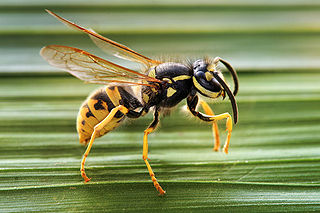| Afrepipona lamptoensis | |
|---|---|
| Scientific classification | |
| Kingdom: | |
| Phylum: | |
| Class: | |
| Order: | |
| Family: | |
| Genus: | |
| Species: | A. lamptoensis |
| Binomial name | |
| Afrepipona lamptoensis Giordani Soika, 1965 | |
Afrepipona lamptoensis is a species of wasp in the Vespidae family. It was described by Giordani Soika in 1965. [1]

A wasp is any insect of the order Hymenoptera and suborder Apocrita that is neither a bee nor an ant. The Apocrita have a common evolutionary ancestor and form a clade; wasps as a group do not form a clade, but are paraphyletic with respect to bees and ants.

The Vespidae are a large, diverse, cosmopolitan family of wasps, including nearly all the known eusocial wasps and many solitary wasps. Each social wasp colony includes a queen and a number of female workers with varying degrees of sterility relative to the queen. In temperate social species, colonies usually only last one year, dying at the onset of winter. New queens and males (drones) are produced towards the end of the summer, and after mating, the queens hibernate over winter in cracks or other sheltered locations. The nests of most species are constructed out of mud, but polistines and vespines use plant fibers, chewed to form a sort of paper. Many species are pollen vectors contributing to the pollination of several plants, being potential or even effective pollinators, while others are notable predators of pest insect species.